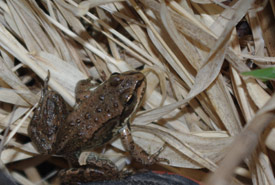Reptiles and amphibians of the Happy Valley Forest

Red eft (the immature form of the spotted newt) are the commonest reptile in the Happy Valley Forest and crowd the forest trails during egg-laying time. (Photo by Dr. Henry Barnett)
The reptile species in the Happy Valley Forest number 19. The area provides one of the last redoubts for the threatened Jefferson’s salamander. Red efts are common, red-backed and spotted salamanders will be regularly seen in the but the...
Update: Four-toed salamander discovery on NCC property in Quebec

Four-toed salamander (Photo by Brian Gratwicke)
Last year, I wrote about the discovery of four-toed salamanders on one of the Nature Conservancy of Canada's (NCC's) properties during a team retreat. Since then, great efforts have been made to learn more about the wetlands on the property that...
My "toad"-ally neat experience in the Crowsnest Pass

Columbia spotted frog at "Calling all Amphibians" CV event, Frayn Property, AB (Photo by NCC)
Did you know there are only 10 amphibian species native to Alberta? I, too, was surprised to learn this. Although I have known basic facts about frogs and toads since I was in elementary school, like how they have a tadpole phase and prefer wet...
World Wildlife Day Round 3: Vote for your favourite reptile or amphibian species

World Wildlife Day: vote for Blanding's turtle (photo by Ryan M. Bolton), gray treefrog (photo by Ryan M. Bolton) or four-toed salamander (photo by Brian Gratwicke)
These may not be your typical fuzzy and cuddly wildlife creatures, but they are no less important in their contribution to nature’s biodiversity. But just how do we differentiate reptiles from amphibians? Here are a few quick facts for the...
Découverte d'une salamandre à quatre orteils sur une propriété nouvelle de CNC

Salamandre à quatre orteils (photo de Brian Gratwicke)
Lors de la retraite d’équipe du Québec du 6 juin par un des sous-groupes formé de Joel Bonin, Julien Poisson, Carine Deland, Caroline Tanguay, Lucie Veillette, Marie-Andrée Tougas-Tellier et Gabrielle...
Earth Day should be every day

Jefferson salamander (Photo by Leo Kenney, Vernal Pool Association)
Earth Day is April 22, 2014. This is the day that we show how much we appreciate the Earth by going green. That includes recycling, reusing materials and reducing the uses of some things. Have you noticed how much garbage is blowing around now...
Deep freeze frogs

Pulling the heavy sled (Photo by NCC)
It’s a chilly day in March when we meet with Dave Prescott, Alberta Fish and Wildlife species at risk biologist, amidst snow drifts and icicles at the Twin Butte General Store. Despite the weekend blizzard and challenging road conditions,...
Island time: The unique biology and geography of island habitats

Cockburn Island, ON (Photo by NCC)
While many Canadians are headed south to escape the frigid temperatures with some island time, we at the Nature Conservancy of Canada (NCC) are warming ourselves by getting to know the islands closer to home, and the species that live in...

